The Michelson-Morley Experiment
Albert Abraham Michelson and Edward Williams Morley
The discovery of the aberration of light was soon followed by an explanation according to the emission theory. The effect was attributed to a simple composition of the velocity of light with the velocity of the earth in its orbit. The difficulties in this apparently sufficient explanation were overlooked until after an explanation on the undulatory theory of light was proposed. This new explanation was at first almost as simple as the former. But it failed to account for the fact proved by experiment that the aberration was unchanged when observations were made with a telescope filled with water. For if the tangent of the angle of aberration is the ratio of the velocity of the earth to the velocity of light, then, since the latter velocity in water is three-fourths its velocity in a vacuum, the aberration observed with a water telescope should be four-thirds of its true value.
On the undulatory theory, according to Fresnel, first, the aether is supposed to be at rest, except in the interior of transparent media, in which, seeondly, it is supposed to move with a velocity less than the velocity of the medium in the ratio

where n is the index of refraction. These two hypotheses give a complete and satisfactory explanation of aberration. The second hypothesis, notwithstanding its seeming improbability, must be considered as fully proved, first, by the celebrated experiment of Fizeau, and secondly, by the ample confirmation of our own work. The experimental trial of the first hypothesis forms the subject of the present paper.
If the earth were a transparent body, it might perhaps be conceded, in view of the experiments just cited, that the inter-molecular aether was at rest in space, notwithstanding the motion of the earth in its orbit; but we have no right to extend the conclusion from these experiments to opaque bodies. But there can hardly be any question that the aether can and does pass through metals. Lorentz cites the illustration of a metallic barometer tube. When the tube is inclined, the aether in the space above the mercury is certainly forced out, for it is incompressible. But again we have no right to assume that it makes its escape with perfect freedom, and if there be any resistance, however slight, we certainly could not assume an opaque body such as the whole earth to offer free passage through its entire mass. But as Lorentz aptly remarks: "Quoi qu’il en soit, on fera bien, mon avis, de ne pas se laisser guider, dans une question aussi importante, par des considrations sur le degr de prob-abilit ou de simplicit de l’une ou de l’autre hypothse, mais de s’addresser a l’exprience pour apprendre connaitre l’tat, de repos ou de mouvement, dans lequel se trouve l’ther la surface terrestre."
In April, 1881, a method was proposed and carried out for testing the question experimentally.
In deducing the formula for the quantity to be measured, the effect of the motion of the earth through the aether on the path of the ray at right angles to this motion was overlooked. The discussion of this oversight and of the entire experiment forms the subject of a very searching analysis by H. A. Lorentz, who finds that this effect can by no means be disregarded. In consequence, the quantity to be measured had in fact but half the value supposed, and as it was already barely beyond the limits of errors of experiment, the conclusion drawn from the result of the experiment might well be questioned; since, however, the main portion of the theory remains unquestioned, it was decided to repeat the experiment with such modifications as would insure a theoretical result much too large to be masked by experimental errors. The theory of the method may be briefly stated as follows:
Let sa, (Fig. 72), be a ray of light which is partly reflected in ab, and partly transmitted in ac, being returned by the mirrors b and c along ba and ca. ba is partly transmitted along ad, and ca is partly reflected along ad. If then the paths ab and ac are equal, the two rays interfere along ad. Suppose now, the aether being at rest, that the whole apparatus moves in the direction sc, with the velocity of the earth in its orbit, the directions and distances traversed by the rays will be altered thus:—The ray sa is reflected along ab, Fig. 73; the angle bab1, being equal to the aberration = is returned along ba1, (aba1 = 2a), and goes to the focus of the telescope, whose direction is unaltered. The transmitted ray goes along ac, is returned along ca1, and is reflected at a1, making ca1e, equal 90 — a, and therefore still coinciding with the first ray. It may be remarked that the rays ba1 and ca1 do not now meet exactly in the same point a1, though the difference is of the second order; this does not affect the validity of the reasoning. Let it now be required to find the difference in the two paths aba1, and aca1.
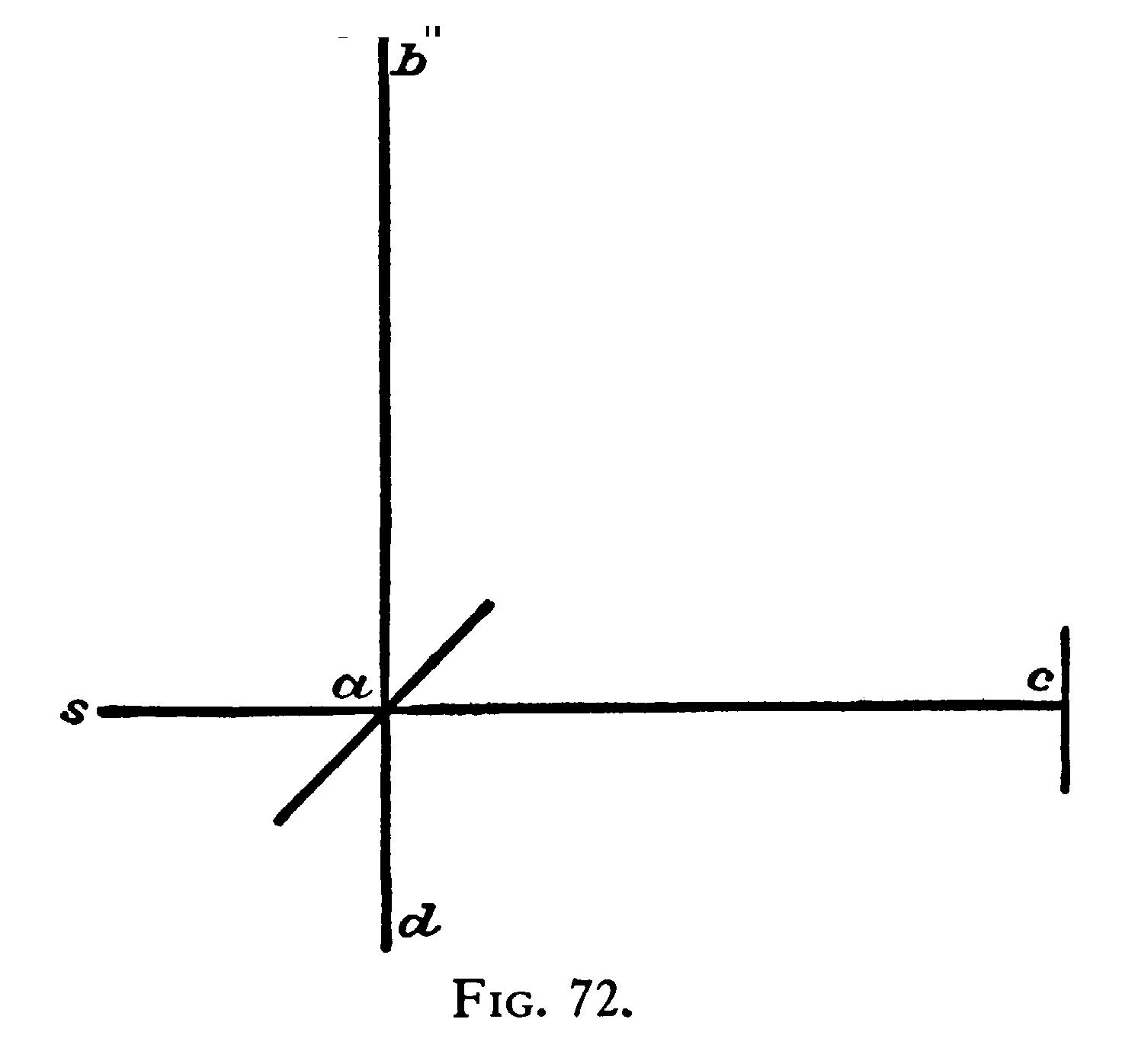
Let V = velocity of light.
v = velocity of the earth in its orbit.
D = distance ab or ac, Fig. 72.
T = time light occupies to pass from a to c.
T1 = time light occupies to return from c to at (Fig. 73).
Then

The whole time of going and coming is

and the distance travelled in this time is

neglecting terms of the fourth order. The length of the other

path is evidently
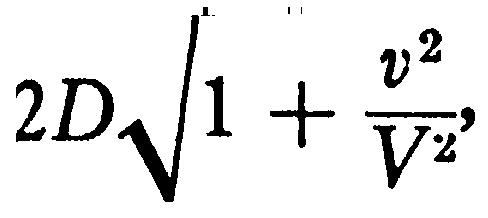
or to the same degree of accuracy,

The difference is therefore
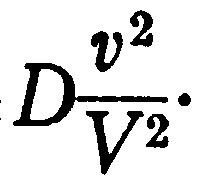
If now the whole apparatus be turned through 90, the difference will be in the opposite direction, hence the displacement of the interference fringes should be
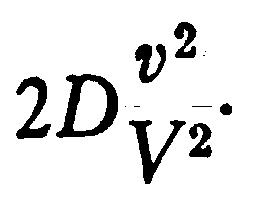
Considering only the velocity of the earth in its orbit, this would be 2D X 10–8. If, as was the case in the first experiment, D = 2 X 106 waves of yellow light, the displacement to be expected would be 0.04 of the distance between the interference-fringes.
In the first experiment, one of the principal difficulties encountered was that of revolving the apparatus without producing distortion; and another was its extreme sensitiveness to vibration. This was so great that it was impossible to see the interference-fringes except at brief intervals when working in the city, even at two o’clock in the morning. Finally, as before remarked, the quantity to be observed, namely, a displacement of something less than a twentieth of the distance between the interference-fringes, may have been too small to be detected when masked by experimental errors.
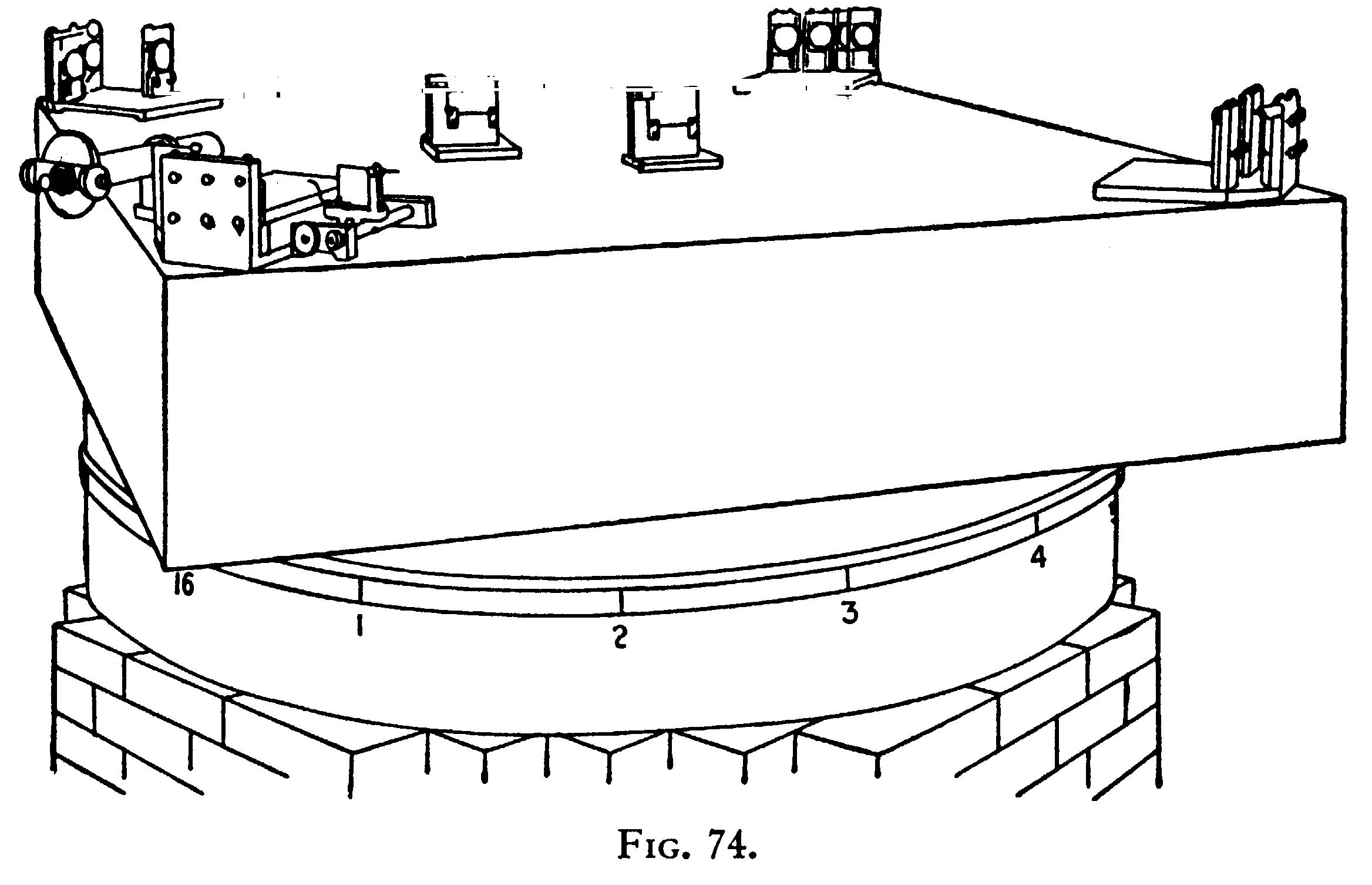
The first-named difficulties were entirely overcome by mounting the apparatus on a massive stone floating on mercury; and the second by increasing, by repeated reflexion, the path of the light to about ten times its former value.
The apparatus is represented in perspective in Fig. 74, in plan in Fig. 75, and in vertical section in Fig. 76. The stone a (Fig. 76) is about 1.5 metre square and 0.3 metre thick. It rests on an annular wooden float bb, 1.5 metre outside diameter, 0.7 metre inside diameter, and 0.25 metre thick. The float rests on mercury contained in the cast-iron trough cc, 1.5 centimetre thick, and of such dimensions as to leave a clearance of about one centimetre around the float. A pin d, guided by arms gggg, fits into a socket e attached to the float. The pin may be pushed into the socket or be withdrawn, by a lever pivoted at f. This pin keeps the float concentric with the trough, but does not bear any part of the weight of the stone. The annular iron trough rests on a bed of cement on a low brick pier built in the form of a hollow octagon.
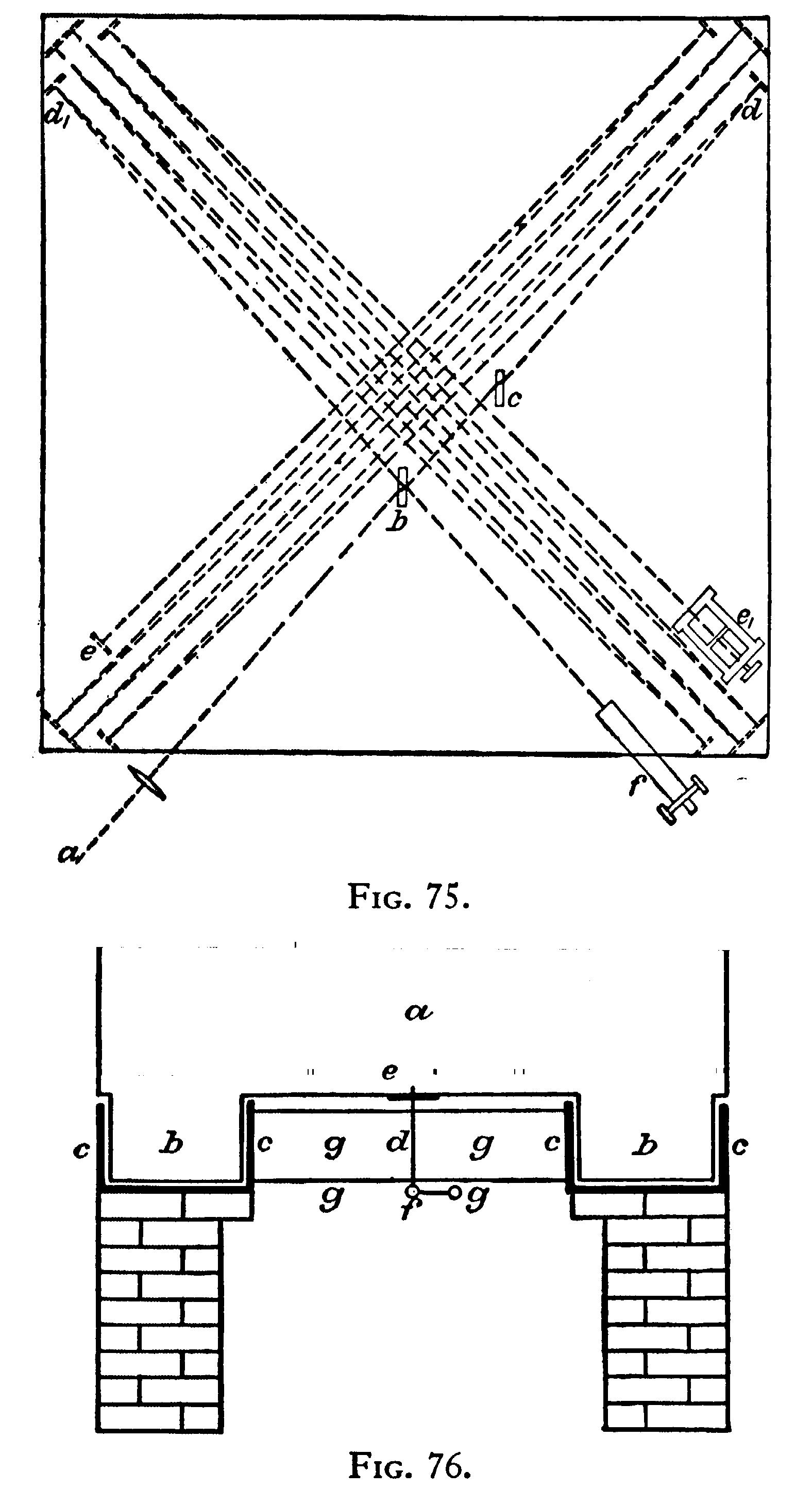
At each corner of the stone were placed four mirrors dd ee, Fig. 75. Near the centre of the stone was a plane parallel glass b. These were so disposed that light from an argand burner a, passing through a lens, fell on b so as to be in part reflected to d; the two pencils followed the paths indicated in the figure, bdedbf and bd1e1d1bf respectively, and were observed by the telescope f. Both f and a revolved with the stone. The mirrors were of speculum metal carefully worked to optically plane surfaces five centimetres in diameter, and the glasses b and c were plane parallel of the same thickness, 1.25 centimetre; their surfaces measured 5.0 by 7.5 centi-metres. The second of these was placed in the path of one of the pencils to compensate for the passage of the other through the Same thickness of glass. The whole of the optical portion of the apparatus was kept covered with a wooden cover to prevent air-currents and rapid changes of temperature.
The adjustment was effected as follows: The mirrors having been adjusted by screws in the castings which held the mirrors, against which they were pressed by springs, till light from both pencils could be seen in the telescope, the lengths of the two paths were measured by a light wooden rod reaching diagonally from mirror to mirror, the distance being read from a small steel scale to tenths of millimetres. The difference in the lengths of the two paths was then annulled by moving the mirror e1. This mirror had three adjustments: it had an adjustment in altitude and one in azimuth, like all the other mirrors, but finer; it also had an adjustment in the direction of the incident ray, sliding forward or backward, but keeping very accurately parallel to its former plane. The three adjustments of this mirror could be made with the wooden cover in position.
The paths being now approximately equal, the two images of the source of light or of some well-defined object placed in front of the condensing lens, were made to coincide, the telescope was now adjusted for distinct vision of the expected interference-bands, and sodium light was substituted for white light, when the interference-bands appeared. These were now made as clear as possible by adjusting the mirror e1; then white light was restored, the screw altering the length of path was very slowly moved (one turn of a screw of one hundred threads to the inch altering the path nearly 1000 wave-lengths) till the coloured interference-fringes reappeared in white light. These were now given a convenient width and position, and the apparatus was ready for observation.
The observations were conducted as follows:—Around the cast-iron trough were sixteen equidistant marks. The apparatus was revolved very slowly (one turn in six minutes) and after a few minutes the cross wire of the micrometer was set on the clearest of the interference-fringes at the instant of passing one of the marks. The motion was so slow that this could be done readily and accurately. The reading of the screw-head on the micrometer was noted, and a very slight and gradual impulse was given to keep up the motion of the stone; on passing the second mark, the same process was repeated, and this was continued till the apparatus had completed six revolutions. It was found that by keeping the apparatus in slow uniform motion, the results were much more uniform and consistent than when the stone was brought to rest for every observation; for the effects of strains could be noted for at least half a minute after the stone came to rest, and during this time effects of change of temperature came into action.
The tables containing the details of the observations are omitted. They are embodied in the curves which follow.
The results of the observations are expressed graphically in Fig. 77. The upper is the curve for the observations at noon, and the lower that for the evening observations. The dotted curves represent one eighth of the theoretical displacements. It seems fair to conclude from the figure that if there is any displacement due to the relative motion of the earth and the luminiferous aether, this cannot be much greater than 0.01 of the distance between the fringes.
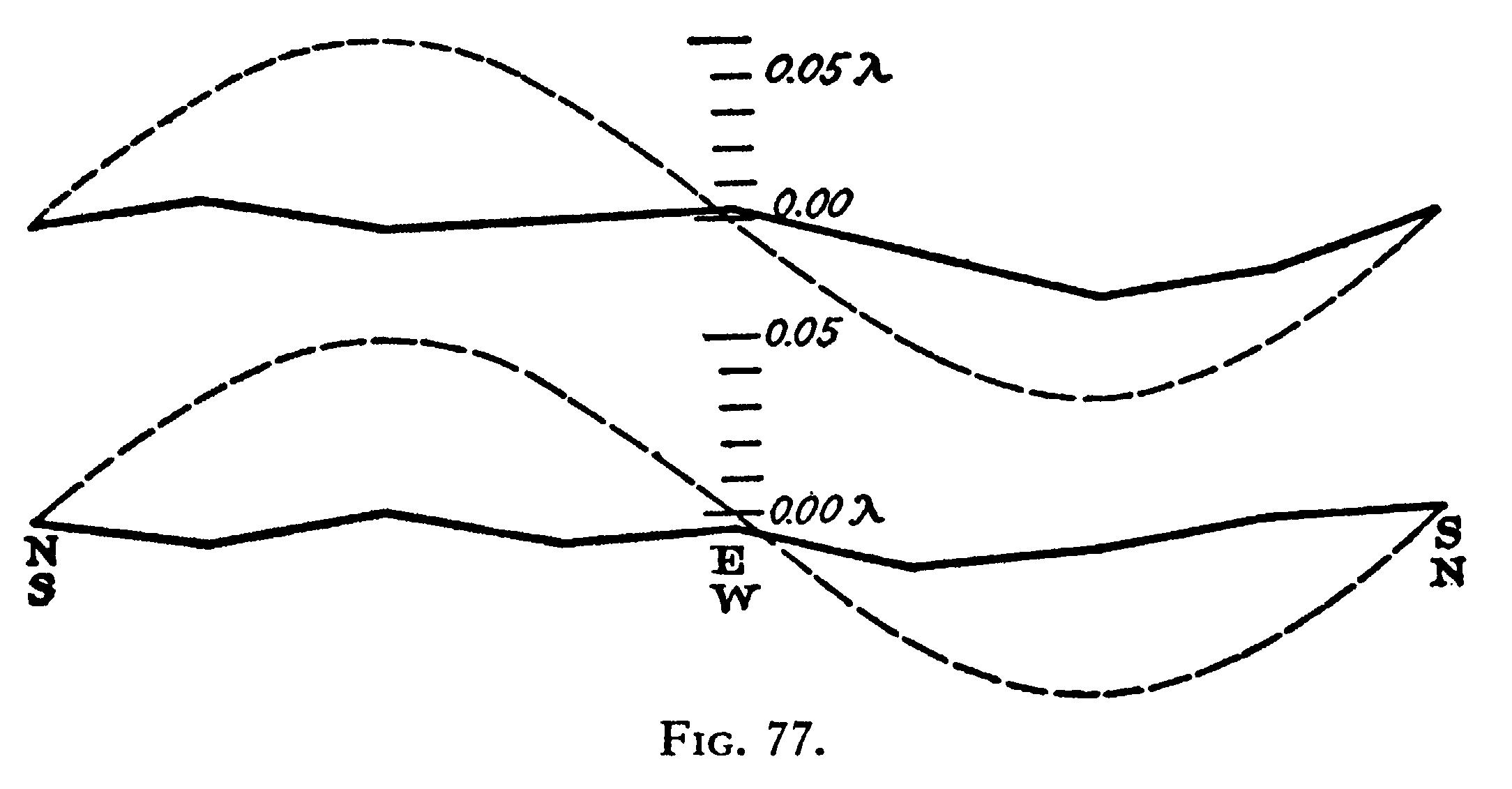
Considering the motion of the earth in its orbit only, this displacement should be

The distance D was about eleven metres, or 2 X l07 wave-lengths of yellow light; hence the displacement to be expected was 0.4 fringe. The actual displacement was certainly less than the twentieth part of this, and probably less than the fortieth part. But since the displacement is proportional to the square of the velocity, the relative velocity of the earth and the aether is probably less than one sixth the earth’s orbital velocity, and certainly less than one fourth.
In what precedes, only the orbital motion of the earth is considered. If this is combined with the motion of the solar system, concerning which but little is known with certainty, the result would have to be modified; and it is just possible that the resultant velocity at the time of the observations was small, though the chances are much against it. The experiment will therefore be repeated at intervals of three months, and thus all uncertainty will be avoided.
It appears from all that precedes reasonably certain that if there be any relative motion between the earth and the luminifer-ous aether, it must be small; quite small enough entirely to refute Fresnel’s explanation of aberration. Stokes has given a theory of aberration which assumes the aether at the earth’s surface to be at rest with regard to the latter, and only requires in addition that the relative velocity have a potential; but Lorentz shows that these conditions are incompatible. Lorentz then proposes a modification which combines some ideas of Stokes and Fresnel, and assumes the existence of a potential, together with Fresnel’s coefficient. If now it were legitimate to conclude from the present work that the aether is at rest with regard to the earth’s surface, according to Lorentz there could not be a velocity potential, and his own theory also fails.